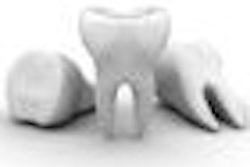

John Olmsted, D.D.S., M.S., a practicing endodontist and part-time faculty member at the University of North Carolina at Chapel Hill, gave a very practical and entertaining overview of current endodontic philosophy during his hands-on training seminar at the ADA meeting. The focus of the sold-out seminar -- attended primarily by GPs, along with a few endodontists -- was instrumentation, but Dr. Olmsted spent just as much time discussing the importance of diagnostics.
In fact, before he got into his presentation on rotary files, resin, and regeneration, he talked about the various tests that should be performed on every patient being considered for a root canal. Proper diagnosis of teeth is imperative, he said, because anywhere from a third to half of the patients referred to him don't need root canal therapy (RCT) at all. He noted that an x-ray is only one part of the diagnosis, even if there is a large radiolucency.
One endodontist in the audience was emphatic that extensive tests are "a waste of our time" if the radiolucency is associated with a tooth having a large, carious lesion. But ultimately she seemed convinced by Dr. Olmstead's comments and slides that he had a valid point regarding the need for testing every suspicious tooth.
Dr. Olmsted recommends ALL the following tests be conducted before a tooth is treated with a root canal (most of this work can be legally delegated to well-trained staff):
Percussion: Sensitivity to lateral percussion indicates periodontal pathology, while sensitivity to vertical percussion is indicative of pulpal problems.
Cold: Dr. Olmsted recommends carbon dioxide ice for practitioners who do a lot of RCT. It is colder than Endo-Ice so it will go through crowns, temporaries, and large amalgams. He uses a dipstick to apply it, starting with the most posterior tooth and moving forward through the entire quadrant. For thermal testing, if hot sets it off and cold relieves the tooth, it's probably a pulpal issue.
Digital electric pulp tester (EPT): The newer EPTs can be combined with an apex locator, and they don't cause the patient discomfort like older models. The tip should be placed on the dry, facial surface of the tooth unless you use toothpaste as a conducting medium. "You're looking for a range of responses" from high to low, he said. All healthy teeth will be in a similar range.
Biting pressure: Most of the doctors in the room said they use the Tooth Sleuth device to test for sensitivity to biting. A mirror handle or soft saliva ejector will also suffice. Ask the patient if it hurts when they bite and when they release pressure.
Palpation: Check the cortical plate for expansion, and check the muscles of mastication and TMJ area for tenderness. Patients with TMJ problems have tender masseter muscles, and the pain is worse when they wake up.
Periodontal: "This is the first instrument I pick up," Dr. Olmsted said, because his staff has performed the other tests and recorded the information for him. He probes all six line angles. A straight vertical pocket in a clean mouth means an endo lesion draining or a vertical fracture.
Transillumination: Place the light source on the lingual and look for changes in color indicating recent or old trauma. Look for fracture and craze lines.
Anesthetic test: This is the last test Dr. Olmstead does. If the patient doesn't know if the pain is mandibular or maxillary in origin, he gives a block on the lower arch first, then he does a thermal test. If the patient still has symptoms, he does local injections in the maxillary until he isolates the tooth.
With regard to the second R -- resin -- Dr. Olmsted is a big proponent of resin-bonded root canal materials such as Resilon. He calls Thermafil "gutta-percha on a stick." In his experience, resin adds strength to the tooth and it's easier to remove, if necessary.
The final R -- regeneration (regrowing pulp tissue) -- is still undergoing research, but Dr. Olmsted is certain that "in the next five years, you'll be seeing endo totally differently than we do now."
The last part of his session was a review of the new Twisted File, a rotary, nickel titanium file with a triangular cross-section that was recently introduced by the sponsor of the session, SybronEndo. The company claims you can perform RCT faster and safer with this device because the files are stronger and more flexible.
Dentists in the session were given the opportunity to try the Twisted File using plastic blocks and extracted teeth. Patrick Rufo, D.D.S., a cosmetic dentist from El Dorado Hills, CA, felt the seminar "had a lot of benefit" to him even though he refers most of his endodontics to specialist. "The most impressive thing is the strength of the files compared to stainless steel files," he said after the demonstration.
Monica "Dr. mOe" Anderson, D.D.S., is a general dentist, writer, and motivational speaker in Austin, TX.



















